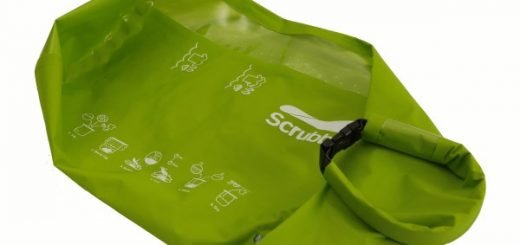15 Freeze Dried Food Pouches Taste Tested & Reviewed for Emergency Meals

Everywhere you look, freeze dried or dehydrated meals are touted as being the quick, easy and tasty way to set up an emergency food supply for you and your family. The marketing line seems to always be some variation on: “Just add hot water and in minutes your family will be enjoying an amazingly delicious, hot, nutritious meal. All of this in an easy to use pouch with an amazing shelf life!” Are these incredible, instant meals something that you and your kids would actually look forward to eating in an emergency? This type of food really is not anything new. The technology to freeze dry things is a product of World War II and dehydrating with the sun was popular with many ancient cultures, including the Romans. Hikers and backpackers have been either enjoying or choking down these kinds of meals for the last three decades. We are going to take a look at the claims of taste, nutrition, shelf life, ease of use and affordability that are often touted by the marketers.
If you are not already familiar, here is a quick background overview:
The Food – Dehydrating and freeze drying are not the same process. Dehydrating usually uses hot air to evaporate the water out of food. It works on everything from fruit chunks to beef jerky. With a little practice, you can do this at home. Freeze drying uses huge pieces of equipment to freeze the food and then evaporate out the water. Freeze drying is a more expensive process that cannot be easily duplicated in your kitchen, other than a serious investment in a HarvestRight machine. But, some ingredients that do not dehydrate well, such as certain beans, can be more easily freeze dried. Also, in general, food that is freeze dried tends to rehydrate more quickly. It is not uncommon to see manufacturers use a mix of freeze dried and dehydrated ingredients to save money.
The Packaging – These meals are able to claim ease of use and an impressive shelf life, in a large part, due to their packaging. The better multilayer pouches function as a “soft can” to keep light, oxygen and moisture away from the food, so it will not degrade or spoil. Many manufacturers will also either nitrogen flush their bags before adding food or, preferably, put an oxygen absorber in the pouch to remove any remaining oxygen after it has been sealed. This extends the storage life by preventing food oxidation. The other big contributor to lifespan is storage temperature. In general, the cooler you store any of these products, the longer they will last.
For this review, we took a look at fifteen dishes from the most commonly seen companies that market their products as a resource for disaster preparedness. They were prepared according to the exact directions on the package, unless otherwise noted. The amount of water used was measured and doubled checked. All of the meals were allowed to sit and rehydrate for an extra ten minutes beyond the labeled time, to give each product a “best case scenario” for consistency and taste comparisons. All of the meals were taste tested by a mixed group of six testers, both adults and children, to get multiple opinions.
Daily Bread Beef Stroganoff with Noodles
In The Pouch:
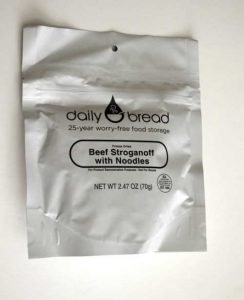
Ready to eat:
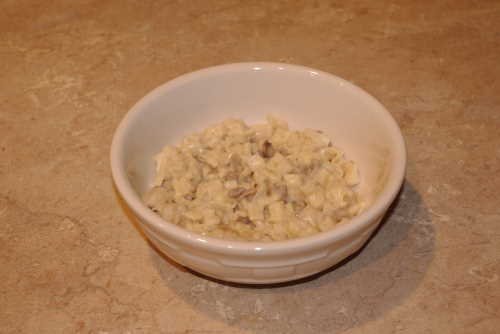
![]() Affordability: Daily Bread used to be only available from sales consultants that came to your house. But, more recently, everyone can shop from their website. A 30 day “premium” supply of meals in cans at 2000 calories a day for one person would cost around $500, before any sales or discounts.
Affordability: Daily Bread used to be only available from sales consultants that came to your house. But, more recently, everyone can shop from their website. A 30 day “premium” supply of meals in cans at 2000 calories a day for one person would cost around $500, before any sales or discounts.
![]() Shelf Life: The product claims a 25 year shelf life. The food is in a heavy duty, multi-layer pouch. An oxygen absorber was in the package.
Shelf Life: The product claims a 25 year shelf life. The food is in a heavy duty, multi-layer pouch. An oxygen absorber was in the package.
![]() Nutrition: The pouch contains one serving of food which is 70g and 320 calories. The meal is high in protein at 13g and fiber at 6g. However, it is also high in saturated fat at 5g and sodium at 940mg.
Nutrition: The pouch contains one serving of food which is 70g and 320 calories. The meal is high in protein at 13g and fiber at 6g. However, it is also high in saturated fat at 5g and sodium at 940mg.
![]() Ease of Use: This meal has a nine minute cook time. The food can successfully be prepared in the pouch. It rehydrates well and is not crunchy or lumpy. When sealed and laid on its side, the pouch’s zipper does not leak.
Ease of Use: This meal has a nine minute cook time. The food can successfully be prepared in the pouch. It rehydrates well and is not crunchy or lumpy. When sealed and laid on its side, the pouch’s zipper does not leak.
![]() Taste: Overall, this meal is one of the best tasting ones that we tested. There were no chemical smells or aftertastes. The kids who tried it said that they would eat it again and there were not adult complaints. There are visible bits of meat and the thick sauce has a creamy flavor. The noodles were firm and not soggy.
Taste: Overall, this meal is one of the best tasting ones that we tested. There were no chemical smells or aftertastes. The kids who tried it said that they would eat it again and there were not adult complaints. There are visible bits of meat and the thick sauce has a creamy flavor. The noodles were firm and not soggy.
Daily Bread Chicken a la King with Noodles
In The Pouch:
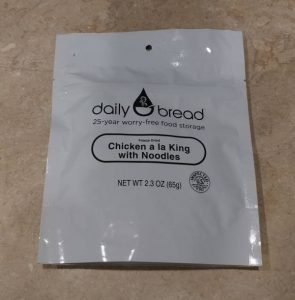
Ready to eat:
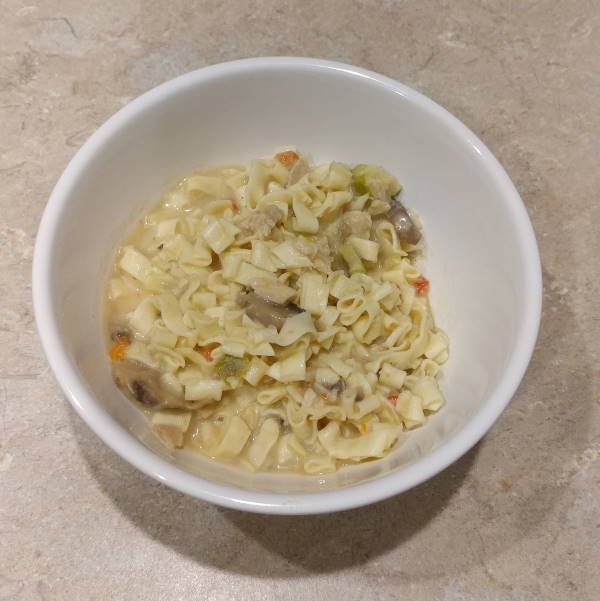
![]() Affordability: Daily Bread used to be only available from sales consultants that came to your house. But, more recently, everyone can shop from their website. A 30 day “premium” supply of meals in cans at 2000 calories a day for one person would cost around $500, before any sales or discounts.
Affordability: Daily Bread used to be only available from sales consultants that came to your house. But, more recently, everyone can shop from their website. A 30 day “premium” supply of meals in cans at 2000 calories a day for one person would cost around $500, before any sales or discounts.
![]() Shelf Life: The product claims a 25 year shelf life. The food is in a heavy duty, multi-layer pouch. An oxygen absorber was in the package.
Shelf Life: The product claims a 25 year shelf life. The food is in a heavy duty, multi-layer pouch. An oxygen absorber was in the package.
![]() Nutrition: The pouch contains one serving of food which is 65g before cooking and comes in at 270 calories. The meal is high in protein at 17g, carbs at 30g and fiber is only 2g. However, it also has a fair amount of sodium at 850mg.
Nutrition: The pouch contains one serving of food which is 65g before cooking and comes in at 270 calories. The meal is high in protein at 17g, carbs at 30g and fiber is only 2g. However, it also has a fair amount of sodium at 850mg.
![]() Ease of Use: This meal has a nine minute cook time. The food can successfully be prepared in the pouch. It rehydrates well and there were no dry spots afterwards. When sealed and laid on its side, the pouch’s zipper does not leak.
Ease of Use: This meal has a nine minute cook time. The food can successfully be prepared in the pouch. It rehydrates well and there were no dry spots afterwards. When sealed and laid on its side, the pouch’s zipper does not leak.
![]() Taste: Overall, this meal received mostly good reviews. The one less enthusiastic reviewer thought that it was a bit salty with a slightly artificial taste to the sauce. Our traditionally pickiest reviewer was on the fence and found it OK, but not amazing. The rest of the testers enjoyed the meal. There are visible chicken chunks, mushrooms and red/green veggie bits. The noodles are small, but were firm and not soggy.
Taste: Overall, this meal received mostly good reviews. The one less enthusiastic reviewer thought that it was a bit salty with a slightly artificial taste to the sauce. Our traditionally pickiest reviewer was on the fence and found it OK, but not amazing. The rest of the testers enjoyed the meal. There are visible chicken chunks, mushrooms and red/green veggie bits. The noodles are small, but were firm and not soggy.
Wise Company Savory Stroganoff
In The Pouch:

Ready to eat:
![]() Affordability: Wise Company meals are sold by the bucket or in bundles. But, based on their website, a thirty day supply works out to ~$180 per person, before any sales or discounts. However, upgrading to “cook in the pouch” type packaging would push the price up to ~$300.
Affordability: Wise Company meals are sold by the bucket or in bundles. But, based on their website, a thirty day supply works out to ~$180 per person, before any sales or discounts. However, upgrading to “cook in the pouch” type packaging would push the price up to ~$300.
![]() Shelf Life: The product claims a 25 year shelf life. The standard food is in a lighter weight Mylar pouch. An oxygen absorber was in the package. The “cook in the pouch” meals use a heavier zippered pouch.
Shelf Life: The product claims a 25 year shelf life. The standard food is in a lighter weight Mylar pouch. An oxygen absorber was in the package. The “cook in the pouch” meals use a heavier zippered pouch.
![]() Nutrition: The pouch contains four servings of food, each of which was 64g and 250 calories. The meal has 6g of protein and 2g of fiber. Saturated fat is only 1g, but sodium comes in at 910mg.
Nutrition: The pouch contains four servings of food, each of which was 64g and 250 calories. The meal has 6g of protein and 2g of fiber. Saturated fat is only 1g, but sodium comes in at 910mg.
![]() Ease of Use: The standard meals are designed to be cooked in a pot, not the bag. There are some meals offered with the upgraded, cook in the pouch type packaging at a higher price. This meal advertised a 15 minute cook time.
Ease of Use: The standard meals are designed to be cooked in a pot, not the bag. There are some meals offered with the upgraded, cook in the pouch type packaging at a higher price. This meal advertised a 15 minute cook time.
![]() Taste: The food has visible spices, but very mild seasoning with a starchy flavor. The consistency was very saucy. Neither of the adults and only one of the kids who tried it said that they would want to eat it again. This was the least popular meal tested.
Taste: The food has visible spices, but very mild seasoning with a starchy flavor. The consistency was very saucy. Neither of the adults and only one of the kids who tried it said that they would want to eat it again. This was the least popular meal tested.
Rainy Day Foods Quick & Easy Macaroni and Cheese
In The Pouch:

Ready to eat:
![]() Affordability: Rainy Day meals are sold by the bucket or in individual pouches. Based on their website, a thirty day supply works out to ~$170 per person, before any sales or discounts. However, there we not any breakfast type meals listed, only lunch and dinner entrees.
Affordability: Rainy Day meals are sold by the bucket or in individual pouches. Based on their website, a thirty day supply works out to ~$170 per person, before any sales or discounts. However, there we not any breakfast type meals listed, only lunch and dinner entrees.
![]() Shelf Life: The manufacturer claims a possible shelf life of up to twenty years, but is quite clear that this is highly dependent on a storage temperature of sixty degrees or less. The package contained an oxygen absorber.
Shelf Life: The manufacturer claims a possible shelf life of up to twenty years, but is quite clear that this is highly dependent on a storage temperature of sixty degrees or less. The package contained an oxygen absorber.
![]() Nutrition: The pouch contained two servings of food, each of which was 90g and 317 calories. The meal has 15g of protein and 6g of fiber. Each serving is also fortified with 98% Vitamin A and 63% Vitamin C, but sodium comes in at 1300mg.
Nutrition: The pouch contained two servings of food, each of which was 90g and 317 calories. The meal has 15g of protein and 6g of fiber. Each serving is also fortified with 98% Vitamin A and 63% Vitamin C, but sodium comes in at 1300mg.
![]() Ease of Use: This product advertises the ability to be cooked in the pouch, but in practice, that does not work well. The cheese powder has a tendency to want to clump while rehydrating and stirring it adequately in the tall, slim pouch full of boiling water is just not feasible without a long backpacking spoon. Upgrading to a wider type of pouch should fix some of these issues, though. That said, rehydration in a pot works much better. This product listed a ten minute cook time.
Ease of Use: This product advertises the ability to be cooked in the pouch, but in practice, that does not work well. The cheese powder has a tendency to want to clump while rehydrating and stirring it adequately in the tall, slim pouch full of boiling water is just not feasible without a long backpacking spoon. Upgrading to a wider type of pouch should fix some of these issues, though. That said, rehydration in a pot works much better. This product listed a ten minute cook time.
![]() Taste: The pasta is very saucy with a convincing cheddar cheesy flavor. There wis a noticeable salty taste to this dish, though. The majority of the adults and kids who tried it would eat it again, but the vote was not unanimous.
Taste: The pasta is very saucy with a convincing cheddar cheesy flavor. There wis a noticeable salty taste to this dish, though. The majority of the adults and kids who tried it would eat it again, but the vote was not unanimous.
Wise Company Pasta Alfredo
In The Pouch:

Ready to eat:
![]() Affordability: Wise Company meals are sold by the bucket or in bundles. But, based on their website, a thirty day supply works out to ~$180 per person, before any sales or discounts. However, upgrading to “cook in the pouch” type packaging would push the price up to ~$300.
Affordability: Wise Company meals are sold by the bucket or in bundles. But, based on their website, a thirty day supply works out to ~$180 per person, before any sales or discounts. However, upgrading to “cook in the pouch” type packaging would push the price up to ~$300.
![]() Shelf Life: The product claims a 25 year shelf life. The standard food is in a lighter weight Mylar pouch. This package did not contain an oxygen absorber. The “cook in the pouch” meals use a heavier zippered pouch.
Shelf Life: The product claims a 25 year shelf life. The standard food is in a lighter weight Mylar pouch. This package did not contain an oxygen absorber. The “cook in the pouch” meals use a heavier zippered pouch.
![]() Nutrition: The pouch contains four servings of food which is 65g and 300 calories. The meal offers 5g of protein and 1g of fiber. The sodium content comes in at 920mg.
Nutrition: The pouch contains four servings of food which is 65g and 300 calories. The meal offers 5g of protein and 1g of fiber. The sodium content comes in at 920mg.
![]() Ease of Use: The standard, less expensive, meals are not designed to be cooked in the bag, so a pot and such is needed. There are some meals offered with the upgraded, cook in the pouch type packaging at a higher price. This meal advertised a 15 minute cook time.
Ease of Use: The standard, less expensive, meals are not designed to be cooked in the bag, so a pot and such is needed. There are some meals offered with the upgraded, cook in the pouch type packaging at a higher price. This meal advertised a 15 minute cook time.
![]() Taste: The finished product looks cheesy with a thick sauce. The noodles have a good texture. The food does have a slightly artificial smell and taste which bothered the adults who tried it, but not the kids who would eat it again.
Taste: The finished product looks cheesy with a thick sauce. The noodles have a good texture. The food does have a slightly artificial smell and taste which bothered the adults who tried it, but not the kids who would eat it again.
Rainy Day Foods Quick & Easy Spaghetti Pasta
In The Pouch:

Ready to eat:
![]() Affordability: Rainy Day meals are sold by the bucket or in individual pouches. But, based on their website, a thirty day supply works out to ~$170 per person, before any sales or discounts. However, there we not any breakfast type meals listed, only lunch and dinner entrees.
Affordability: Rainy Day meals are sold by the bucket or in individual pouches. But, based on their website, a thirty day supply works out to ~$170 per person, before any sales or discounts. However, there we not any breakfast type meals listed, only lunch and dinner entrees.
![]() Shelf Life: The manufacturer claims a possible shelf life of up to twenty years, but is quite clear that this is highly dependent on a storage temperature of sixty degrees or less. The package contains an oxygen absorber.
Shelf Life: The manufacturer claims a possible shelf life of up to twenty years, but is quite clear that this is highly dependent on a storage temperature of sixty degrees or less. The package contains an oxygen absorber.
![]() Nutrition: The pouch contains two servings of food, each of which is 85g and 263 calories. The meal has 13g of protein and 5g of fiber. Each serving is also fortified with 98% Vitamin A and 49% Vitamin C, but sodium comes in at 1079mg.
Nutrition: The pouch contains two servings of food, each of which is 85g and 263 calories. The meal has 13g of protein and 5g of fiber. Each serving is also fortified with 98% Vitamin A and 49% Vitamin C, but sodium comes in at 1079mg.
![]() Ease of Use: This product advertises the ability to be cooked in the pouch, but in practice, that does not work well, due to the design of the pouch. That said, rehydration in a pot works very well. This product lists a ten minute cook time.
Ease of Use: This product advertises the ability to be cooked in the pouch, but in practice, that does not work well, due to the design of the pouch. That said, rehydration in a pot works very well. This product lists a ten minute cook time.
![]() Taste: The pasta cooks up well with no crunchy noodles. The sauce has visible spices and a good, obvious tomato flavor. There is a floury aftertaste to the sauce that some testers picked up on. Also the TVP bits were commented on as not being meaty or meat-like. Half of the testers would eat it again, if it was served.
Taste: The pasta cooks up well with no crunchy noodles. The sauce has visible spices and a good, obvious tomato flavor. There is a floury aftertaste to the sauce that some testers picked up on. Also the TVP bits were commented on as not being meaty or meat-like. Half of the testers would eat it again, if it was served.
Mountain House Beef Stroganoff with Noodles
In The Pouch:

Ready to eat:
![]() Affordability: Mountain House is available at most camping or outdoors stores, as well as multiple online vendors. The cost varies a bit by vendor, but a 30 day supply of meals for one person would cost around $190, before any sales or discounts.
Affordability: Mountain House is available at most camping or outdoors stores, as well as multiple online vendors. The cost varies a bit by vendor, but a 30 day supply of meals for one person would cost around $190, before any sales or discounts.
![]() Shelf Life: This brand originally claimed a 7 year shelf life. However they have internally tested food pouches that were 30 years old and have updated their shelf life accordingly. The food is in a heavy duty, multi-layer pouch. An oxygen absorber is in the package.
Shelf Life: This brand originally claimed a 7 year shelf life. However they have internally tested food pouches that were 30 years old and have updated their shelf life accordingly. The food is in a heavy duty, multi-layer pouch. An oxygen absorber is in the package.
![]() Nutrition: The pouch contains two and a half servings of food, each of which is 54g before cooking and 250 calories. The meal was high in protein at 10g and fiber at 5g. Sodium came in at 730mg.
Nutrition: The pouch contains two and a half servings of food, each of which is 54g before cooking and 250 calories. The meal was high in protein at 10g and fiber at 5g. Sodium came in at 730mg.
![]() Ease of Use: This meal has a nine minute cook time. The food can successfully be prepared in the pouch. It rehydrates well with no surprises. When sealed and laid on its side, the pouch’s zipper does not leak.
Ease of Use: This meal has a nine minute cook time. The food can successfully be prepared in the pouch. It rehydrates well with no surprises. When sealed and laid on its side, the pouch’s zipper does not leak.
![]() Taste: Overall, this meal is one of the better tasting ones tested. It both smells and tastes like beef stroganoff. There are visible bits of meat and the thick sauce has a creamy flavor. The noodles were firm and not soggy. The kids who tried it said that they would eat it again and only one of the adults had some reservations.
Taste: Overall, this meal is one of the better tasting ones tested. It both smells and tastes like beef stroganoff. There are visible bits of meat and the thick sauce has a creamy flavor. The noodles were firm and not soggy. The kids who tried it said that they would eat it again and only one of the adults had some reservations.
Mountain House Beef Stroganoff with Noodles
In The Pouch:
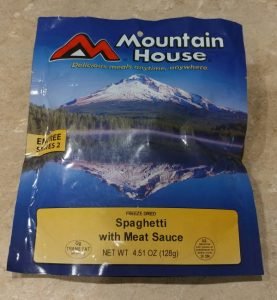
Ready to eat:
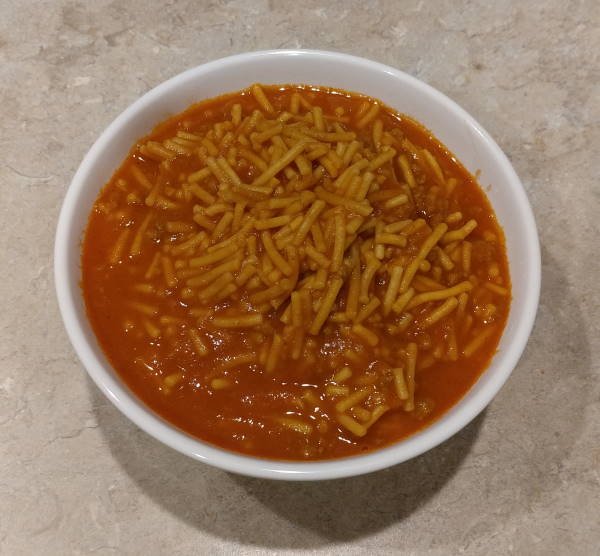
![]() Affordability: Mountain House is available at most camping or outdoors stores, as well as multiple online vendors. The cost varies a bit by vendor, but a 30 day supply of meals for one person would cost around $190, before any sales or discounts.
Affordability: Mountain House is available at most camping or outdoors stores, as well as multiple online vendors. The cost varies a bit by vendor, but a 30 day supply of meals for one person would cost around $190, before any sales or discounts.
![]() Shelf Life: This brand originally claimed a 7 year shelf life. However they have internally tested food pouches that were 30 years old and have updated their shelf life accordingly. The food is in a heavy duty, multi-layer pouch. An oxygen absorber is in the package.
Shelf Life: This brand originally claimed a 7 year shelf life. However they have internally tested food pouches that were 30 years old and have updated their shelf life accordingly. The food is in a heavy duty, multi-layer pouch. An oxygen absorber is in the package.
![]() Nutrition: The pouch contains two servings of food, each of which is 64g before cooking and 270 calories. The meal was high in protein at 14g and sodium at 1110mg. Each serving also has 7g fat, 39g carbohydrates and 3g fiber. The dish provides 20% Vitamin A and Iron, as well as 30% Vitamin C.
Nutrition: The pouch contains two servings of food, each of which is 64g before cooking and 270 calories. The meal was high in protein at 14g and sodium at 1110mg. Each serving also has 7g fat, 39g carbohydrates and 3g fiber. The dish provides 20% Vitamin A and Iron, as well as 30% Vitamin C.
![]() Ease of Use: This meal has a nine minute cook time. The food can successfully be prepared in the pouch. It rehydrates well with no surprises. When sealed and laid on its side, the pouch’s zipper does not leak.
Ease of Use: This meal has a nine minute cook time. The food can successfully be prepared in the pouch. It rehydrates well with no surprises. When sealed and laid on its side, the pouch’s zipper does not leak.
![]() Taste: Overall, this meal was accepted by all the reviewers. One commented that it reminded them of SpaghettiOs. There are visible but small bits of meat and the sauce smells and tastes of tomatoes. The noodles are cut into short sections, but were firm and not soggy.
Taste: Overall, this meal was accepted by all the reviewers. One commented that it reminded them of SpaghettiOs. There are visible but small bits of meat and the sauce smells and tastes of tomatoes. The noodles are cut into short sections, but were firm and not soggy.
Mountain House Chicken Teriyaki with Rice
In The Pouch:

Ready to eat:
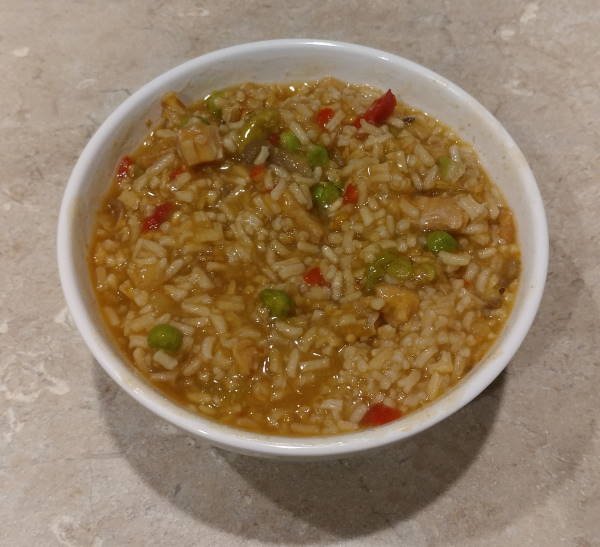
![]() Affordability: Mountain House is available at most camping or outdoors stores, as well as multiple online vendors. The cost varies a bit by vendor, but a 30 day supply of meals for one person would cost around $190, before any sales or discounts.
Affordability: Mountain House is available at most camping or outdoors stores, as well as multiple online vendors. The cost varies a bit by vendor, but a 30 day supply of meals for one person would cost around $190, before any sales or discounts.
![]() Shelf Life: This brand originally claimed a 7 year shelf life. However they have internally tested food pouches that were 30 years old and have updated their shelf life accordingly. The food is in a heavy duty, multi-layer pouch. An oxygen absorber is in the package.
Shelf Life: This brand originally claimed a 7 year shelf life. However they have internally tested food pouches that were 30 years old and have updated their shelf life accordingly. The food is in a heavy duty, multi-layer pouch. An oxygen absorber is in the package.
![]() Nutrition: The pouch contains two servings of food, each of which is 71g before cooking and 280 calories. The meal was high in protein at 13g and sodium at 780mg. Each serving only has 3g fat and 2g fiber, but 50g carbohydrates . The dish provides 20% Vitamin C.
Nutrition: The pouch contains two servings of food, each of which is 71g before cooking and 280 calories. The meal was high in protein at 13g and sodium at 780mg. Each serving only has 3g fat and 2g fiber, but 50g carbohydrates . The dish provides 20% Vitamin C.
![]() Ease of Use: This meal has a nine minute cook time. The food can successfully be prepared in the pouch. It rehydrates well with just some initial shaking. When sealed and laid on its side, the pouch’s zipper does not leak.
Ease of Use: This meal has a nine minute cook time. The food can successfully be prepared in the pouch. It rehydrates well with just some initial shaking. When sealed and laid on its side, the pouch’s zipper does not leak.
![]() Taste: This meal was a total success with all of our reviewers. One commented “I’d take this for lunch” and another mentioned how it tasted exactly like his expectations for chicken teriyaki. There are visible chicken and veggie bits. The sauce is thick and sweet.
Taste: This meal was a total success with all of our reviewers. One commented “I’d take this for lunch” and another mentioned how it tasted exactly like his expectations for chicken teriyaki. There are visible chicken and veggie bits. The sauce is thick and sweet.
Mountain House Fusilli Pasta with Italian Sausage
In The Pouch:
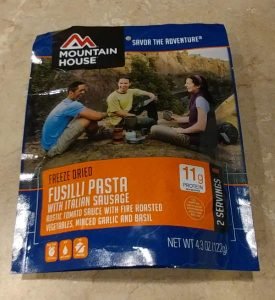
Ready to eat:
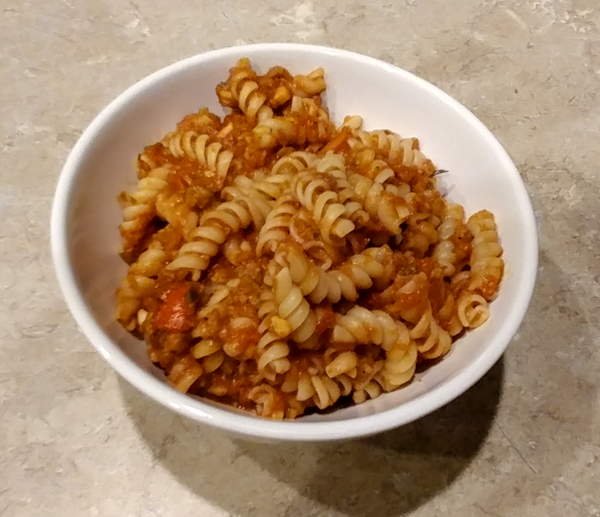
![]() Affordability: Mountain House is available at most camping or outdoors stores, as well as multiple online vendors. The cost varies a bit by vendor, but a 30 day supply of meals for one person would cost around $190, before any sales or discounts.
Affordability: Mountain House is available at most camping or outdoors stores, as well as multiple online vendors. The cost varies a bit by vendor, but a 30 day supply of meals for one person would cost around $190, before any sales or discounts.
![]() Shelf Life: This brand originally claimed a 7 year shelf life. However they have internally tested food pouches that were 30 years old and have updated their shelf life accordingly. The food is in a heavy duty, multi-layer pouch. An oxygen absorber is in the package.
Shelf Life: This brand originally claimed a 7 year shelf life. However they have internally tested food pouches that were 30 years old and have updated their shelf life accordingly. The food is in a heavy duty, multi-layer pouch. An oxygen absorber is in the package.
![]() Nutrition: The pouch contains two servings of food, each of which is 61g before cooking and 260 calories. The meal provided 11g protein and 780mg sodium. Each serving also has 8g fat and 3g fiber, with 34g carbohydrates . The dish provides 20% Iron.
Nutrition: The pouch contains two servings of food, each of which is 61g before cooking and 260 calories. The meal provided 11g protein and 780mg sodium. Each serving also has 8g fat and 3g fiber, with 34g carbohydrates . The dish provides 20% Iron.
![]() Ease of Use: This meal has a nine minute cook time. The food can successfully be prepared in the pouch. It rehydrates well with just some initial shaking, although the directions do suggest an extra round of stirring at the half way point. When sealed and laid on its side, the pouch’s zipper does not leak.
Ease of Use: This meal has a nine minute cook time. The food can successfully be prepared in the pouch. It rehydrates well with just some initial shaking, although the directions do suggest an extra round of stirring at the half way point. When sealed and laid on its side, the pouch’s zipper does not leak.
![]() Taste: Fusilli Pasta was a big hit with two-thirds of our reviewers. The less enthusiastic reviews thought that it was “OK” with no one rating it “bad”. The sauce definitely reminds me of homemade pasta sauce and is certainly one of the better rehydrated ones that we’ve tried. The sausage is small, crumbled bits mixed into the sauce.
Taste: Fusilli Pasta was a big hit with two-thirds of our reviewers. The less enthusiastic reviews thought that it was “OK” with no one rating it “bad”. The sauce definitely reminds me of homemade pasta sauce and is certainly one of the better rehydrated ones that we’ve tried. The sausage is small, crumbled bits mixed into the sauce.
Mountain House Chicken Fajita Bowl
In The Pouch:
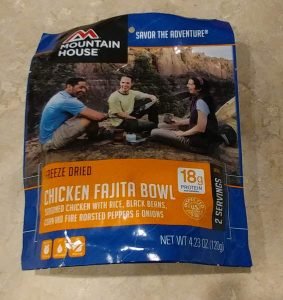
Ready to eat:
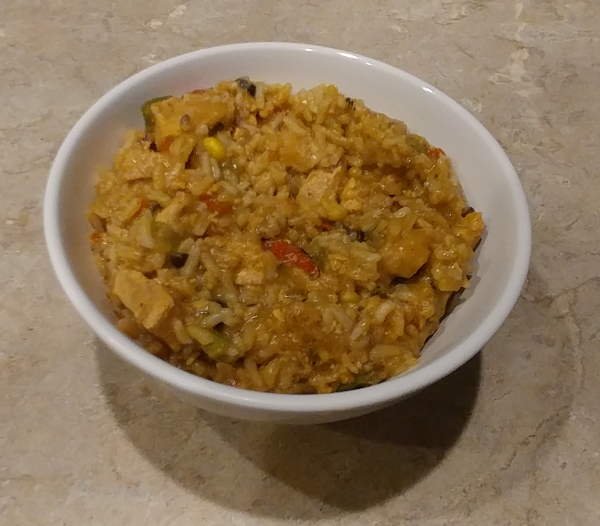
![]() Affordability: Mountain House is available at most camping or outdoors stores, as well as multiple online vendors. The cost varies a bit by vendor, but a 30 day supply of meals for one person would cost around $190, before any sales or discounts.
Affordability: Mountain House is available at most camping or outdoors stores, as well as multiple online vendors. The cost varies a bit by vendor, but a 30 day supply of meals for one person would cost around $190, before any sales or discounts.
![]() Shelf Life: This brand originally claimed a 7 year shelf life. However they have internally tested food pouches that were 30 years old and have updated their shelf life accordingly. The food is in a heavy duty, multi-layer pouch. An oxygen absorber is in the package.
Shelf Life: This brand originally claimed a 7 year shelf life. However they have internally tested food pouches that were 30 years old and have updated their shelf life accordingly. The food is in a heavy duty, multi-layer pouch. An oxygen absorber is in the package.
![]() Nutrition: The pouch contains two servings of food, each of which is 60g before cooking and 280 calories. The meal provided 18g protein and 690mg sodium. Each serving also has 10g fat and 4g fiber, with 30g carbohydrates . The dish provides 50% Vitamin C and 20% Vitamin A.
Nutrition: The pouch contains two servings of food, each of which is 60g before cooking and 280 calories. The meal provided 18g protein and 690mg sodium. Each serving also has 10g fat and 4g fiber, with 30g carbohydrates . The dish provides 50% Vitamin C and 20% Vitamin A.
![]() Ease of Use: This meal has a nine minute cook time. The food can successfully be prepared in the pouch. It rehydrates well with just some initial shaking, although the directions do suggest an extra round of stirring at the half way point. When sealed and laid on its side, the pouch’s zipper does not leak.
Ease of Use: This meal has a nine minute cook time. The food can successfully be prepared in the pouch. It rehydrates well with just some initial shaking, although the directions do suggest an extra round of stirring at the half way point. When sealed and laid on its side, the pouch’s zipper does not leak.
![]() Taste: Chicken Fajita Bowl was rated “good” by most of our reviewers. The consensus was that this would be an excellent filling for tortillas, if available, to make a burrito. It is one of the few dishes to have large chunks of actual meat, which was a nice change of pace.
Taste: Chicken Fajita Bowl was rated “good” by most of our reviewers. The consensus was that this would be an excellent filling for tortillas, if available, to make a burrito. It is one of the few dishes to have large chunks of actual meat, which was a nice change of pace.
Valley Food Storage Irish Pub Style Cheddar Potato
In The Pouch:

Ready to eat:

![]() Affordability: Valley Food Storage is available from their website and on Amazon.com. The cost varies a bit by vendor, but a “One Month Premium Kit” of meals for one person would cost around $400, before any sales or discounts.
Affordability: Valley Food Storage is available from their website and on Amazon.com. The cost varies a bit by vendor, but a “One Month Premium Kit” of meals for one person would cost around $400, before any sales or discounts.
![]() Shelf Life: The product claims a 25 year shelf life. The meal that we received came packed in a Mylar pouch. The pouches are nitrogen purged and contain oxygen absorbers.
Shelf Life: The product claims a 25 year shelf life. The meal that we received came packed in a Mylar pouch. The pouches are nitrogen purged and contain oxygen absorbers.
![]() Nutrition: The pouch contain five servings of food, each of which is 62g before cooking and 280 calories. The meal was high in fat at 11g, protein 6g and carbs at 39g. Sodium was one of the lowest of the meals tested at 630mg.
Nutrition: The pouch contain five servings of food, each of which is 62g before cooking and 280 calories. The meal was high in fat at 11g, protein 6g and carbs at 39g. Sodium was one of the lowest of the meals tested at 630mg.
![]() Ease of Use: This meal has a seven minute cook time. This is a variation on potato soup with visible square potato flakes in the pouch. A cooking tip is to give the pouch contents another good stir before serving, just due to the potato flakes settling during rehydration.
Ease of Use: This meal has a seven minute cook time. This is a variation on potato soup with visible square potato flakes in the pouch. A cooking tip is to give the pouch contents another good stir before serving, just due to the potato flakes settling during rehydration.
![]() Taste: Overall, our taste testers liked the Irish Pub Style Irish Potato Soup. The general agreement was that, although it is not quite as good as homemade potato soup, it is better than anything else that we have gotten from the store. It is a nice, thick soup with clearly visible potato pieces that all rehydrated well and has an obvious cheese flavor. There are also occasional bits of peppers in the mix.
Taste: Overall, our taste testers liked the Irish Pub Style Irish Potato Soup. The general agreement was that, although it is not quite as good as homemade potato soup, it is better than anything else that we have gotten from the store. It is a nice, thick soup with clearly visible potato pieces that all rehydrated well and has an obvious cheese flavor. There are also occasional bits of peppers in the mix.
Valley Food Storage White Bean & Lime Chili
In The Pouch:

Ready to eat:

![]() Affordability: Valley Food Storage is available from their website and on Amazon.com. The cost varies a bit by vendor, but a “One Month Premium Kit” of meals for one person would cost around $400, before any sales or discounts.
Affordability: Valley Food Storage is available from their website and on Amazon.com. The cost varies a bit by vendor, but a “One Month Premium Kit” of meals for one person would cost around $400, before any sales or discounts.
![]() Shelf Life: The product claims a 25 year shelf life. The meal that we received came packed in a Mylar pouch. The pouches are nitrogen purged and contain oxygen absorbers.
Shelf Life: The product claims a 25 year shelf life. The meal that we received came packed in a Mylar pouch. The pouches are nitrogen purged and contain oxygen absorbers.
![]() Nutrition: The pouch contain five servings of food, each of which is 60g before cooking and 220 calories. The meal was high in protein 11g, fiber 12g and carbs at 35g. Sodium content was 860mg.
Nutrition: The pouch contain five servings of food, each of which is 60g before cooking and 220 calories. The meal was high in protein 11g, fiber 12g and carbs at 35g. Sodium content was 860mg.
![]() Ease of Use: This meal has a twelve minute cook time. When looking in the pouch, we could see obvious and recognizable ingredients, such as beans, onion bits and pepper pieces. This pouch also benefited from a second good stir before serving.
Ease of Use: This meal has a twelve minute cook time. When looking in the pouch, we could see obvious and recognizable ingredients, such as beans, onion bits and pepper pieces. This pouch also benefited from a second good stir before serving.
![]() Taste: The White Bean & Lime Chili is excellent. Personally, I thought it was delicious and certainly good enough to take on backpacking trips or other non-emergency adventures. The other testers agreed. All of the ingredients rehydrated properly, as well as also having clear and distinct flavors. The jalapeno and cayenne peppers give the chili enough of a kick to keep it interesting. It is not eye-wateringly hot chili, but there is some spiciness there.
Taste: The White Bean & Lime Chili is excellent. Personally, I thought it was delicious and certainly good enough to take on backpacking trips or other non-emergency adventures. The other testers agreed. All of the ingredients rehydrated properly, as well as also having clear and distinct flavors. The jalapeno and cayenne peppers give the chili enough of a kick to keep it interesting. It is not eye-wateringly hot chili, but there is some spiciness there.
Valley Food Storage Pasta Primavera
In The Pouch:

Ready to eat:

![]() Affordability: Valley Food Storage is available from their website and on Amazon.com. The cost varies a bit by vendor, but a “One Month Premium Kit” of meals for one person would cost around $400, before any sales or discounts.
Affordability: Valley Food Storage is available from their website and on Amazon.com. The cost varies a bit by vendor, but a “One Month Premium Kit” of meals for one person would cost around $400, before any sales or discounts.
![]() Shelf Life: The product claims a 25 year shelf life. The meal that we received came packed in a Mylar pouch. The pouches are nitrogen purged and contain oxygen absorbers.
Shelf Life: The product claims a 25 year shelf life. The meal that we received came packed in a Mylar pouch. The pouches are nitrogen purged and contain oxygen absorbers.
![]() Nutrition: The pouch contain five servings of food, each of which is 50g before cooking and 190 calories. The meal’s stats are protein 6g, fiber 1g and carbs at 34g. Sodium content was 600mg.
Nutrition: The pouch contain five servings of food, each of which is 50g before cooking and 190 calories. The meal’s stats are protein 6g, fiber 1g and carbs at 34g. Sodium content was 600mg.
![]() Ease of Use: This meal has a seven minute preparation time. This was the only one of the meals tested that did not do all that well when rehydrated per the directions. Some of the pasta pieces were still just a little north of al dente. But, five more minutes and an extra stir half way through “simmering” was enough.
Ease of Use: This meal has a seven minute preparation time. This was the only one of the meals tested that did not do all that well when rehydrated per the directions. Some of the pasta pieces were still just a little north of al dente. But, five more minutes and an extra stir half way through “simmering” was enough.
![]() Taste: The Pasta Primavera has a strong cheese flavor along the lines of parmesan or asiago. This was the surprise favorite meal of our family’s “picky eater” member of the testing team. One of the other testers did note that the sauce was “a bit thin” due to bag cooking, but the taste was well received.
Taste: The Pasta Primavera has a strong cheese flavor along the lines of parmesan or asiago. This was the surprise favorite meal of our family’s “picky eater” member of the testing team. One of the other testers did note that the sauce was “a bit thin” due to bag cooking, but the taste was well received.
Valley Food Storage Thai Coconut Curry
In The Pouch:
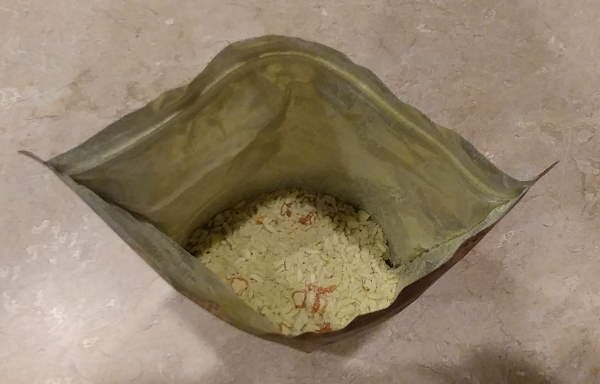
Ready to eat:

![]() Affordability: Valley Food Storage is available from their website and on Amazon.com. The cost varies a bit by vendor, but a “One Month Premium Kit” of meals for one person would cost around $400, before any sales or discounts.
Affordability: Valley Food Storage is available from their website and on Amazon.com. The cost varies a bit by vendor, but a “One Month Premium Kit” of meals for one person would cost around $400, before any sales or discounts.
![]() Shelf Life: The product claims a 25 year shelf life. The meal that we received came packed in a Mylar pouch. The pouches are nitrogen purged and contain oxygen absorbers.
Shelf Life: The product claims a 25 year shelf life. The meal that we received came packed in a Mylar pouch. The pouches are nitrogen purged and contain oxygen absorbers.
![]() Nutrition: The pouch contain five servings of food, each of which is 80g before cooking and 300 calories. The meal was high in saturated fat at 10g, protein 6g and carbs at 56g. Sodium was a reasonable 660mg.
Nutrition: The pouch contain five servings of food, each of which is 80g before cooking and 300 calories. The meal was high in saturated fat at 10g, protein 6g and carbs at 56g. Sodium was a reasonable 660mg.
![]() Ease of Use: This meal has a nine minute cook time. This is a variation on meatless coconut curry that looks like a mix of rice, white coconut powder and veggie flakes in the pouch. When measuring and following the preparation directions, the curry turned out just a bit watery.
Ease of Use: This meal has a nine minute cook time. This is a variation on meatless coconut curry that looks like a mix of rice, white coconut powder and veggie flakes in the pouch. When measuring and following the preparation directions, the curry turned out just a bit watery.
![]() Taste: This dish was judged inedible by all of our reviewers.
Taste: This dish was judged inedible by all of our reviewers.
Results:
Advertising claiming “delicious” or “gourmet” should be taken with a very large grain of salt. Before stocking up, you should have the members of your family taste each dish you plan to buy, as we found a lot of individual variation in what the testers liked enough to eat without complaining. Sticking with one company is not an easy fix, as the Wise Co. Alfredo was popular with all of the kids, but the Wise Co. Stroganoff was literally spit into the trashcan.
However, the biggest issue is in the calorie content of the food. The meals are advertised and sold according to “servings”. However, these servings are often severely limited in calories. In general, it is recommended that women eat 2000 calories a day and men consume 2500 calories. A breakfast, lunch and dinner of these freeze dried meals often only provides in the range of 900 to 1200 calories a day, total, for all three servings. By comparison, a McDonald’s Big Mac with a medium Coke and fries is just over 1100 calories for the one meal. If you bought the “one year’s supply” of food advertised by some these companies and tried to live off of it at the advertised levels, you would slowly starve to death.
When figuring that you would need to double or triple the amount of “servings” needed to reach the advertised levels of preparedness, then these meals get expensive. The biggest benefits are really convenience and shelf life. The less expensive meals are not designed to be cooked in the pouch, so a pot, a method of cleaning it and disposing of the wastewater will have to be available for preparation. The “cook in the pouch” meals are the clear winner here.
As for shelf life, it is standard practice to advertise the best case scenario in these calculations. Food stored in a cool basement is going to fare much better than the same type of meals stored in a garage with seasonal temperature variations.
In the past, I have eaten these kinds of meals for up to a week at a time. But, this is with consuming a more realistic two or three “servings” of food per meal and supplementing the meals with nuts, dried fruit and other sources of vitamins. It is not realistic to make any kind of long term plan based on just these meals without at least doubling up on servings.
Where meals from a pouch makes the most sense is as a piece of a larger food plan. They would be good in a bug out bag for quick meals on the road, as when you had to leave town in a hurry to escape a tropical storm. Freeze dried meals also make sense to keep as an emergency supply in the corner of the pantry, as a first step to a larger plan. They can provide a quick way to step up your level of readiness from zero to a week or more with minimal work and no maintenance. However, for longer term reserves, incorporating freeze dried foods along with a pantry rotation plan and other strategies would make the most sense.
![]()
To find out more about cooking in emergencies, check out the seven kinds of survival stoves that you can trust.
If you are looking to get ready for the future, then take a look at our updated list of survival gear deals.
To learn about more aspects of emergency preparedness, then check out our free online survival skills training.






